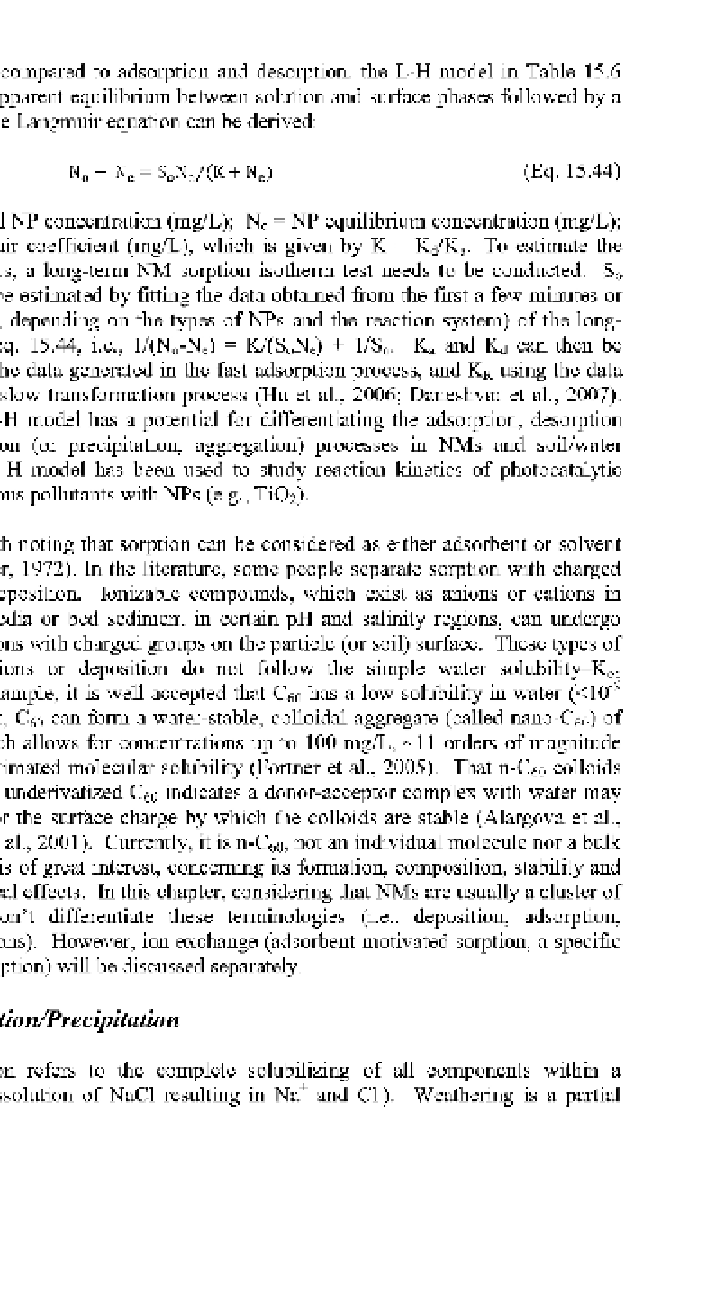Environmental Engineering Reference
In-Depth Information
15.6) is slow as compared to adsorption and desorption, the L-H model in Table 15.6
leads to a rapid apparent equilibrium between solution and surface phases followed by a
slow reaction. The Langmuir equation can be derived:
N
0
- N
e
= S
0
N
e
/(K + N
e
)
(Eq. 15.44)
where N
0
= initial NP concentration (mg/L); N
e
= NP equilibrium concentration (mg/L);
and K = Langmuir coefficient (mg/L), which is given by K = Kd/K
a
. To estimate the
kinetic parameters, a long-term NM sorption isotherm test needs to be conducted. S
0
and K will then be estimated by fitting the data obtained from the first a few minutes or
hours (e.g., 24 h, depending on the types of NPs and the reaction system) of the long-
term tests with eq. 15.44, i.e., l/(N
0
-N
e
) = K/(S
0
N
e
) + 1/S
0
. K
a
and K
d
can then be
estimated using the data generated in the fast adsorption process, and KR using the data
generated in the slow transformation process (Hu et al., 2006; Daneshvar et al., 2007).
Therefore, the L-H model has a potential for differentiating the adsorption, desorption
and transformation (or precipitation, aggregation) processes in NMs and soil/water
systems. The L-H model has been used to study reaction kinetics of photocatalytic
oxidation of various pollutants with NPs (e.g., TiC>2).
It is worth noting that sorption can be considered as either adsorbent or solvent
motivated (Weber, 1972). In the literature, some people separate sorption with charged
interactions or deposition. lonizable compounds, which exist as anions or cations in
water, porous media or bed sediment in certain pH and salinity regions, can undergo
specific interactions with charged groups on the particle (or soil) surface. These types of
sorptive interactions or deposition do not follow the simple water solubility-K
o
c
relations. For example, it is well accepted that Ceo has a low solubility in water (<10"
9
mg/L). However, Ceo can form a water-stable, colloidal aggregate (called nano-Ceo) of
-5-500 nm, which allows for concentrations up to 100 mg/L, ~11 orders of magnitude
more than the estimated molecular solubility (Fortner et al., 2005). That n-Ceo colloids
are comprised of underivatized Ceo indicates a donor-acceptor complex with water may
be responsible for the surface charge by which the colloids are stable (Alargova et al.,
2001; Deguchi et al., 2001). Currently, it is n-Ceo, not an individual molecule nor a bulk
solid of Ceo that is of great interest, concerning its formation, composition, stability and
potential biological effects. In this chapter, considering that NMs are usually a cluster of
materials, we don't differentiate these terminologies (i.e., deposition, adsorption,
charged interactions). However, ion exchange (adsorbent motivated sorption, a specific
category of adsorption) will be discussed separately.
15.3.2 Dissolution/Precipitation
Dissolution refers to the complete solubilizing of all components within a
mineral (e.g., dissolution of NaCl resulting in Na
+
and Cl"). Weathering is a partial

Search WWH ::

Custom Search